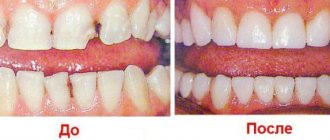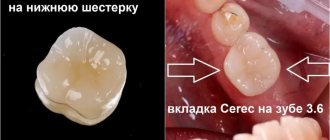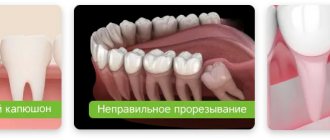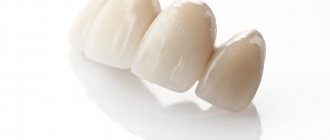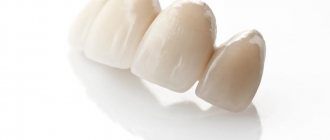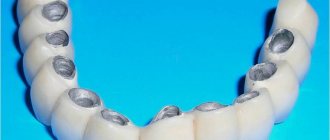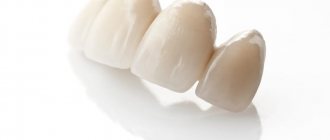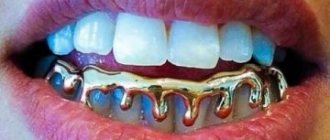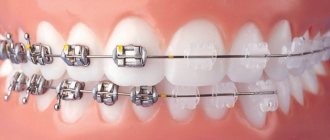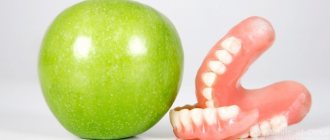- Why and when is extension needed?
- Main indications for extensions
- Extension techniques
- How to grow your front teeth?
- Advantages and disadvantages of extensions
- Contraindications
- FAQ
- Price
- Reviews
Dental augmentation is an effective procedure that can eliminate a number of dental defects most simply and quickly, without resorting to implantation.
It is especially in demand when it comes to the front teeth, the appearance of which ensures the aesthetics of the entire smile area. It is important that if you follow the recommendations, the result obtained will be long-term and will allow you to solve the existing problem for many years. For one patient, the use of such a tooth will be 5, for another – 10 or 20 years. How long an extended tooth lasts depends on many factors, the technique and materials used, the skill of the dentist, and the products included in the diet. Care will also play an important role. Due to the consumption of coffee, red wine, or smoking, the color may change, which will require a repeat event.
At the same time, restoring a tooth without a pin will make it possible to guarantee a longer service life. However, in a number of cases, it will not be possible to do without the use of such a technique to strengthen the affected tooth.
Indications and contraindications for tooth augmentation
Teeth augmentation is a multi-stage technology for restoring the aesthetic appearance and functions of the jaw, which was susceptible to chipping or erased as a result of increased tone of the masticatory muscles, called buxism.
Indications for the tooth augmentation procedure:
- chips resulting from injuries;
- numerous caries lesions;
- large distance between teeth;
- wedge-shaped defect;
- the presence of a gap between the two front teeth;
- congenital structural pathologies;
- thinning and demineralization of enamel due to consumption of junk food and lack of oral hygiene;
- cervical caries;
- the presence of errors in previous dental sessions that resulted in the destruction of healthy tissue;
- malocclusion.
Having asked the dentist a question about what tooth extension is called, the patient will immediately hear the answer. The procedure is called dentition restoration. Modern extension technologies make it possible to restore the structure in most cases without resorting to its removal. The procedure is harmless, but has a number of contraindications:
- patient age – more than 60 years;
- children's age when using pins;
- presence of a cyst;
- inflammation of the gums;
- pregnancy in the first or third trimester;
- failure to comply with personal hygiene rules;
- periodontitis and stomatitis;
- jaw fracture and other injuries.
If a patient is diagnosed with diseases that are contraindications, the dentist first treats them, and then restores the dentition.
In what cases is extension applied?
Despite the fact that tooth tissues have high density and strength, they can be destroyed for various reasons.
Firstly, pulpless teeth are often subject to destruction. Once the nerves are removed, they are no longer supplied with nutrition, their tissues demineralize and become fragile. Fragments can break off from the edges or chewing surface, and subsequently the teeth can become significantly damaged.
Secondly, teeth can be severely damaged from sports or household trauma, from chewing or biting off very hard food. In such cases, small chips of the edges, chewing surfaces, and cracks are common [2]. Children's front teeth often suffer due to accidental injuries.
In these cases, tooth augmentation helps restore the lost part of a broken tooth, in which the missing fragments are molded by a specialist from a composite material [2]. Front teeth augmentation is also successfully used in pediatric dentistry, where, thanks to modern materials and methods, pediatric specialists are able to restore a damaged tooth, which reliably serves the little patient until it is replaced with a permanent one.
Some dental procedures may expose the root. In this case, extensions help cover the sensitive area.
In addition, the extension procedure is also used in aesthetic dentistry to eliminate certain defects. Among them [3].
- difference due to anatomical and physiological characteristics of the shape, size, length of an individual tooth in a row;
- difference in tooth color;
- the presence of large interdental spaces;
- defects in the closure of the dentition.
Dental bonding is the most appropriate way to restore chipped teeth
“The 8 Best Ways to Improve Your Smile” American Dental Association
Teeth extension methods
There are 2 main extension methods:
- Straight. Used if tooth decay is up to 30%. During the procedure, composite or photopolymer materials are used to build teeth. The former are less durable and harden after 30 minutes. The latter have a service life of 10 years and remain plastic until exposed to the lamp.
- Indirect. Applicable when damage affects no more than 70% of the structure. The method has several stages, including taking impressions, making and installing ceramic inlays.
If you have ever thought about whether a crown or extension is better, then you should know that a crown is installed when more than 70% of the tissue is destroyed, but a intact and healthy root remains.
What is extension
Tooth augmentation is a dental procedure that involves restoring the lost crown using special dental composite materials. This manipulation is used to solve therapeutic and aesthetic problems in both adult and pediatric dentistry. It is quite popular due to its relative speed and cost-effectiveness, especially in comparison with more complex and invasive procedures such as the installation of crowns or veneers [1].
Features of front teeth extensions
Restoration of anterior teeth is carried out in the following cases:
- Yellowing of enamel;
- Damage to caries;
- Minor curvature;
- Presence of chips or chips;
- Grayish-yellow coating.
Composites and photopolymers are used for extensions, but veneers are the most popular. They are used for minor damage to healthy tissue. If the tooth body is deeply damaged, it is removed from the roots and an implant is implanted in its place. Types of veneers presented in our clinic: composite veneers, ceramic veneers.
Chips of baby teeth often occur in childhood. Many parents do not pay attention to this, hoping for the speedy growth of indigenous children. This is wrong, as the sharp edges scratch the tongue, causing inflammation and infection. Children's extensions are made using composite materials and are absolutely painless.
Correction with crowns
If the tooth is severely damaged, but the root is not destroyed, correction with crowns is used. The technique is implemented on the front and chewing teeth. Crowns are installed when it is impossible to install a filling - when the carious cavity is too extensive, when the tooth is destroyed by 70% or more.
How to install a crown:
- The tooth is prepared, freed from affected tissue, and the walls are ground down;
- An impression is made and sent to the dental laboratory.
- The finished crown is tried on and installed.
Modern technologies make it possible to obtain crowns that perfectly imitate the transparency, shade and texture of natural teeth.
Tooth extension onto a pin
When thinking about whether it is possible to build a tooth onto the root, the use of a pin comes to mind. It is used if both the body and the root are severely damaged.
The procedure includes:
- obtaining an x-ray;
- cleaning the mouth, removing stones;
- removal of damaged areas;
- computer tooth modeling;
- removal of saliva;
- anesthesia;
- cleaning of channels;
- implantation of a pin, cleansing the area around it;
- filling the space around the pin with a composite or photopolymer;
- polishing and grinding.
Dentists build up teeth under crowns only if the remainder is in good condition and does not rot or decompose.
Price
- Primary appointment (examination, consultation) with a dentist (special offer) 100001
For free
Promotion
- Restoring a tooth with a filling (Restoration) 140007
6 900 ₽
- Tooth restoration with filling materials using anchor/fiberglass pins (restoration) 140009
8 900 ₽
- Tooth restoration with inlay (E.max) 152012
19 900 ₽
- Tooth restoration with a crown (E.max) 152013
21 900 ₽
- Tooth restoration with Veneer, Half-crown (E.max) 152014
21 900 ₽
- Tooth restoration with a full zirconium crown 152015
13 900 ₽
- Tooth restoration with a metal-ceramic crown 152019
13 900 ₽
Teeth extension is aimed at restoring their anatomical shape and color. Used for chips, cracks, and changes in enamel shade. Allows you to correct congenital dental anomalies and eliminate interdental gaps. Methods and materials for extensions are selected depending on the type of defect. These can be composite restorations, installation of pins, inlays, veneers or crowns. The chosen option affects the cost of treatment.
Does it hurt to grow teeth?
Tooth extension is a painless procedure. Anesthesia is not performed if the damage is not significant, since manipulations are carried out at a superficial level. If the damage is severe, the dentist administers local anesthesia. Modern drugs begin to act immediately after administration.
After the session, the first day you may experience pain if the canals were cleaned. Painkillers will help you feel better.
The restored dentition will last a long time if the patient provides proper care. If the question arises about whether it is possible to smoke after tooth extensions, the answer will be negative. Composite and photopolymer materials quickly absorb all substances, which is why the filling quickly changes color. Maintaining hygiene and regular visits to the dentist will help you maintain your smile for a long time.
Dental correction methods
In dental practice, there are various technologies used for dental restoration. Most often, patients are offered to use simple extensions using a light filling. This restoration method is good because it does not require nerve removal. You can grow a tooth that will not differ from healthy ones in just one visit to the doctor. To restore the tooth to its original appearance, the dentist carries out:
- comprehensive hygiene, removing soft and hard plaque;
- preparation, during which the color of the filling is selected, anesthetic is administered, caries is eliminated or old fillings are removed, and the tooth is protected from saliva using a latex lining;
- a procedure to restore a tooth using filling material directly;
- finishing correction (grinding, polishing).
Providing a guarantee for the provision of services related to dental treatment is the direct responsibility of the dentist.
But the patient who consults the doctor bears no less responsibility for maintaining the beautiful and healthy appearance of the treated teeth. In order to admire the work of a dentist for as long as possible and prevent the defect from forming again, a person must take good care of his teeth and oral cavity. It’s not for nothing that one of the common causes of dental pain is poor hygiene. Moscow metro station Zvezdnaya, Danube Avenue, 23
Methods for front and chewing teeth
Depending on the clinical situation, the following methods are used:
- composite art restoration;
- extension on a pin;
- recovery by tabs;
- installation of veneers;
- fixation of crowns.
| Defect | Front tooth | Chewing |
| Small chip | Composite Veneers | Composite |
| A piece of a tooth broke off | Composite Veneers | Composite Tab |
| No half a tooth | On the pin Veneers Crown | On the pin Tab Crown |
| No tooth wall | — | On the pin Crown |
| Destroyed tooth to the root | On the pin Crown | Crown with root strengthening core tab or pin |
| Teeth worn out | Composite Veneers Crown | Composite Tab Crown |
| Gap between teeth | Composite Veneers Crown | — |
Pros and cons of extensions
The objective advantages of artistic restoration include:
- safety (the method is suitable even for children),
- possibility of restoration even with significant chips,
- high degree of strength of the extended part,
- natural appearance.
As for the disadvantages, these include the comparative high cost. Despite the variety of methods and price categories, most often this procedure is not cheap.
Another disadvantage is that to ensure safe conditions for the restored area, it becomes necessary to wear a mouth guard during sleep.
Which restoration method to choose?
There is no clear answer here for obvious reasons. It all depends on the degree of damage that the crown and root have. If we talk about the direct method, it is as gentle as possible, since its implementation does not require first removing the nerves. The composite material is applied to the crown in layers. At the same time, the tooth is still “alive” and is able to perform its original functions.
It is not possible to use the indirect method without first removing the nerves. An orthopedist implants inlays and pins into the root canals of a tooth with a dead nerve, after which a layer-by-layer application of composite material is performed. If the patient has significant damage to the crown, this extension option is the only possible one.
Is it possible to grow a tooth without a root?
If a tooth is without a root, there is no support for building structures. Therefore, it can only be restored with the help of implantation or prosthetics.
- Implantation. It involves restoring a lost tooth by installing an implant into the jaw, which acts as a tooth root. The top of the implant is covered with a crown.
- Dental bridge. It is a prosthetic structure consisting of several crowns welded together. The outer ones are attached to the pre-ground teeth adjacent to the defect, while the central ones remain hinged.
- Removable prosthesis Butterfly. Refers to temporary removable dentures. Indicated for hiding an aesthetic defect during the period of implantation or the manufacture of a permanent prosthesis. However, if the patient has contraindications to implantation and basic prosthetic methods, it can be used long-term. Attached to adjacent teeth using clasps.
